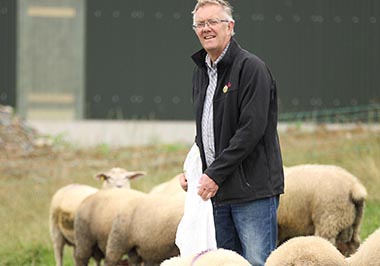Farm Incomes are a Wake Up call on the Need for Decisions, says UFU.
The Ulster Farmers’ Union says the drop in farm incomes in 2018 is disappointing, but does not come as surprise. UFU president, Ivor Ferguson, said that with weeks to go until Brexit the figures underline the continuing dependence of direct support for agriculture. “Despite the lack of firm decisions on future support arrangements these figures must be a wake up call that these cannot be indefinitely delayed,” he said.

The provisional income figures from DAERA show a total income drop of £107 million, down 24 per cent, to £360 million. The UFU says this needs to be seen in the context of there being less money available for farmers to invest or spend in their local community. “Even with all the changes we have seen in rural areas their financial fortunes still ebb and flow with the success or otherwise of agriculture,” said the UFU president.
The figures confirm that despite continuing general growth in both quantity and price of outputs, farmers are being hit by rising costs for all inputs. Feed makes up 55 per cent of the bill as costs there rose by 13 per cent. “This is the other side of the coin of price gains from the weakening of sterling. Most inputs such as feed, chemicals, fuel and fertilisers link back to euro or US dollar prices.
“These increases and higher labour costs are putting a squeeze on margins when incomes are just about static,” said Mr Ferguson.
There has also been a reduction forecasted in average farm business incomes for 2018/2019 but the UFU says it is particularly concerned about the plunge in incomes in both hill and lowland beef and sheep production. “This is a threat to the very backbone of agriculture. If farmers are unable to cover rising input costs its future is in doubt. That would be a massive blow to the industry. Tacking this issue must be central to whatever new farm support structures are put in place after Brexit,” said the UFU president.
The UFU says the harsh reality of the figures is an industry squeezed by static returns and rising costs, with its future uncertain. “Look behind these and of the £360 million total income, £286 million was made up of direct support from Brussels through the CAP. That is why decisions on how this will be replaced after Brexit cannot be allowed to drift even further,” warned Mr Ferguson.
Northern Ireland agricultural incomes in 2018
The Department of Agriculture, Environment and Rural Affairs (DAERA) today published the first (provisional) estimate for farm incomes in 2018. Revisions have been made to previous years.
Aggregate Agricultural Income
Provisional figures indicate that the ‘Total Income from Farming’ (TIFF) in Northern Ireland fell by 23% (24% in real terms) from £467million in 2017 to £360million in 2018.
TIFF represents the return on own labour, management input and own capital invested for all those with an entrepreneurial involvement in farming. It represents farm income measured at the sector level.
Total Gross Output for agriculture in Northern Ireland was 1% higher at £2.13billion in 2018. There was a 2% increase in the value of output from the livestock sector, while field crops rose by 3% and horticulture was 5% lower. These figures are for the calendar year and therefore they represent the outturn across two harvest years.
Dairying remains the largest contributor to the total value of Gross Output at £680million in 2018; a rise of 3%. Between 2017 and 2018, the annual average farm-gate milk price remained at 28.7 pence per litre while the volume of raw milk produced in Northern Ireland increased by 3% to 2.3 billion litres.
The output value of cattle was 1% higher at £467million in 2018. The total number of animals slaughtered increased by 2% in 2018, whereas, the average carcase weights for both clean and cull animals were 1% higher. These increases resulted in the volume of meat produced being 2% higher in 2018. The average producer price for finished clean cattle was £3.49 per kilogram in 2018 while the average producer price for cull animals was £2.51 per kilogram. These prices were 0.4% and 1.7% higher than the respective averages for 2017. The aforementioned increases in meat volumes and prices were mostly offset by a downward movement in stocks.
The value of output from sheep increased by 8% to £78million in 2018. The total number of sheep slaughtered decreased by 2% in 2018 whereas the average carcass weight remained unchanged at 22 kilograms. This resulted in the volume of sheep meat produced being 2% lower in 2018. The average producer price increased by 7% to £4.26 per kg. In addition to these changes in meat volumes and prices there was also an upward movement in stocks that contributed to the increased output value for 2018.
There were increases in the values of output in two of the three intensive livestock sectors during 2018, with the poultry sector improving by 5% to £281million and the egg sector growing by 3% to £107million. The value of pig output reduced by 5% to £159 million. All three sectors recorded an increase in production volumes, with eggs up by 7%, poultry up by 4% and pigs up by 3% compared with the previous year. The producer prices in the eggs and pig sectors reduced by 4% and 6% respectively, whereas, the producer price for poultry increased by 1%.
The total output value for field crops increased by 3% in 2018 to £66million. This was as a result of increases in the prices for barley, wheat and oats. Values across a calendar year reflect two harvests. The value of output of potatoes in 2018 decreased by 9% to £21million. This was due to a decrease in potato production as a result of both lower area grown and lower yield achieved in 2018. The value of output for barley increased by 24% to £22million and the output value of wheat decreased by 20% to £9million.
The value of output recorded in the Horticulture sector was lower year on year for 2018, at £107million. Mushrooms is the largest contributor to this sector in value terms, with an estimated output value of £51million.
The estimated value of the 2018 direct subsidies (Basic, Greening and Young Farmer payments) was £286million, representing a decrease of 0.6%, when compared with the 2017 payments.
The total value of Gross Inputs increased by 8% in 2018, to £1.58billion. Feedstuff costs, which accounted for 55% of the total Gross Input estimate, rose by 13% to £867million in 2018. There was a 5% increase in the volume of feedstuffs purchased and a 7% increase in the average price paid per tonne.
The total cost of fertilisers in 2018 decreased by 1% as a net result of a 6% fall in the volume purchased and a 6% increase in the average price paid per tonne. There was a 13% rise in total lime purchases, with the result that total expenditure on fertilisers and lime increased by 1% to £85million.
Total machinery expenses increased by 5% to £156million in 2018, as a result of a 10% increase in the cost of fuel and oils. This is in line with the global commodity price during the year.
A detailed document covering the period 2013–2018 and containing all the key figures used to derive TIFF in Northern Ireland can be downloaded from the DAERA website:
www.daera-ni.gov.uk/articles/
Estimates for the United Kingdom will not be released until April to May 2019 and a breakdown of TIFF for the UK will not be available until then.
Farm level incomes
These income results are based on farm accounts collected as part of the Northern Ireland Farm Business Survey (FBS). This is a representative sample of farms larger than 0.5 Standard Labour Requirements. The income figures presented are for accounting years with an average end date of mid-February.
Farm Business Income measured across all farm types is expected to decrease from an average £33,870 in 2017/18 to £26,030 in 2018/19, i.e. a decrease of £7,840 or 23% per farm.
Farm Business Income is also expected to fall (by varying amounts) for Dairy, Cattle and Sheep (LFA), Cattle and Sheep (Lowland), Pigs and Mixed farm types between 2017/18 and 2018/19. For all these farm types with the exception of Pigs, the downturn in their incomes is mainly attributed to higher feed costs in the 2018/19 accounting year. The downturn in incomes for Pig farms is due to both lower pig prices and higher feed prices in 2018/19. The results also show that Cereals are the only farm type expected to show a rise in Farm Business Income for 2018/19 when compared with the previous year. The upturn in incomes for Cereal farms is due to higher grain and straw prices in the 2018/19 accounting year.
A detailed analysis of farm incomes by type and size of farm in 2017/18 will be provided in the report ‘Farm Incomes in Northern Ireland 2017/18’ which will be published on the DAERA website in March 2019:

























